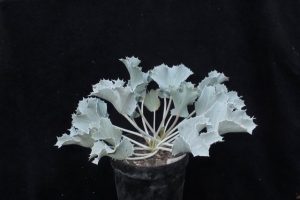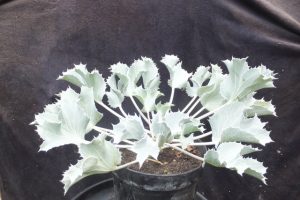You need be careful with Eryngium maritinum in your greenhouse, those leathery leaves have tips sharper than holly, thus the common name. Fortunately Sea Holly does not make a large plant, just a foot or so high and across, of exceptionally beautifully hued foliage. The colour is hard to capture in photographs, less green and more bluish white, almost sea coloured. The surface so finely textured it is both matt and with a sheen, again much like the sea.

Perhaps for camouflage as Sea Holly was a native hardy maritime plant of our seashore where it was found growing in the dunes right down to below the high tide line. I say was because it’s seldom seen now, and the reason is simple.
Shakespeare refers to sugary Eringoes made from the thong like roots. These were not very appealing culinary items, except for one, somewhat fatal, point, they were considered powerful aphrodisiacs. This did indeed prove fatal for Sea Holly as the roots were dug from the wild until no more could be found.
These roots are very long to penetrate deep down into the dune or shore to keep the plant from washing away in a high tide. Closely related garden species of Eryngium are often multiplied by cutting their similar long roots into pieces, which also keeps their varieties true. This is possible for Sea Holly, however better plants for foliage are had sooner from seed.

Sow in sandy gritty free draining compost, in a deep pot and preferably one per pot so you do not break up the root-ball when you pot up. Move to a larger deeper pot as the plant grows, water just keeping the compost damp and never waterlog. I add a little salt rather than fertiliser though I doubt this is necessary.
With most garden species you would be looking forward to the beautiful flowers however with Sea Holly these, though still pretty, are short lived and not such value as the foliage. Thus nip out the flowering stem when it appears. If you let the teasel like flower set this seriously weakens pot grown plants as they just can’t grow the extensive root system they need to ripen seed.

Evolved to cope with the parching light of sand and seashore Sea Hollies like full sun and sulk in the shade. Keep them up on the bench but set back so you don’t catch those spines. In winter they drop their leaves and can go under the bench till growth resumes again in spring


